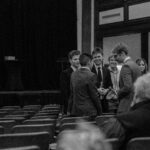One of the highlights of this past presidential inauguration was a reading by the first United States Youth Poet Laureate, Amanda Gorman. She read a poem entitled “The Hill We Climb,” inspired and fueled by the Capitol riots. Instead of projecting a negative energy while watching this fearful scene, she finds hope in the way we can move past these events. “For there is always light,” she read on Inauguration Day, “if only we’re brave enough to see it. If only we’re brave enough to be it.”
Her role in the hopefulness of this year’s inauguration is undeniable. People were tweeting about her for days afterward. Artists and normal citizens alike looked to her as a beacon of hope in this tumultuous era.
However, many people mistook her for the first Poet Laureate of the United States rather than being the first Youth Poet Laureate of the U.S. The role of United States Poet Laureate has been in existence for 84 years, with the current Poet Laureate being Joy Harjo, the first Native American to hold the position.
The Poet Laureate holds an important role, as does the Youth Poet Laureate, in helping spread awareness of the role of the arts and using their artistic role for philanthropy. We need these people to help keep the arts in the limelight, as Gorman did, but the arts continue to be pushed by the wayside.
According to Statista, the United States has stagnated in its National Endowment for the Arts spending at approximately $150 million. Military spending, however, has remained at around $725 billion over the past 20 years. I believe that the arts deserve a bit more financial attention than they have been getting.
Many people misconstrue the National Endowment for the Arts as a write-off for poor artists who don’t get much work done, but that is far from the truth. A large part of the National Endowment of the Arts is even related to the problem with military spending: the Creative Forces program. This program was created to help veterans, with help from the U.S. Department of Defense and Veterans Affairs, to gain access to arts programs which can help with any remaining physical or mental problems they may be dealing with after combat.
The Endowment has also aided minority voices in art to gain a larger stage. Grants have been lent to historically black colleges across the U.S., allowing for the arts programs in these schools to get the funding they deserve.
The Endowment has also partnered with tribal colleges and universities with the intention of, according to their website, “resilience, reclamation, and relevance.” A conference they funded for these tribal colleges even included the aforementioned U.S. Poet Laureate Joy Harjo, wherein they discussed “the issues affecting Native arts and culture today, such as the need to use language, arts, and historic preservation to revitalize Native communities; the role of indigenous arts in social change; advancing the truth about Native culture through research and cultural resources; and reimagining Native visibility and identity in urban areas.”
The National Endowment for the Arts has an important role in the United States, one that cannot be understated nor stamped out. In order for voices of hope like Amanda Gorman’s to emerge, we must keep our government accountable for funding programs like the Endowment.
Hope, reconciliation and unity are things we all strive for, but without the arts that hope is all we can hold on to. In order to keep progressing as a nation toward a future we all can enjoy, the arts must hold a place within our governance.








